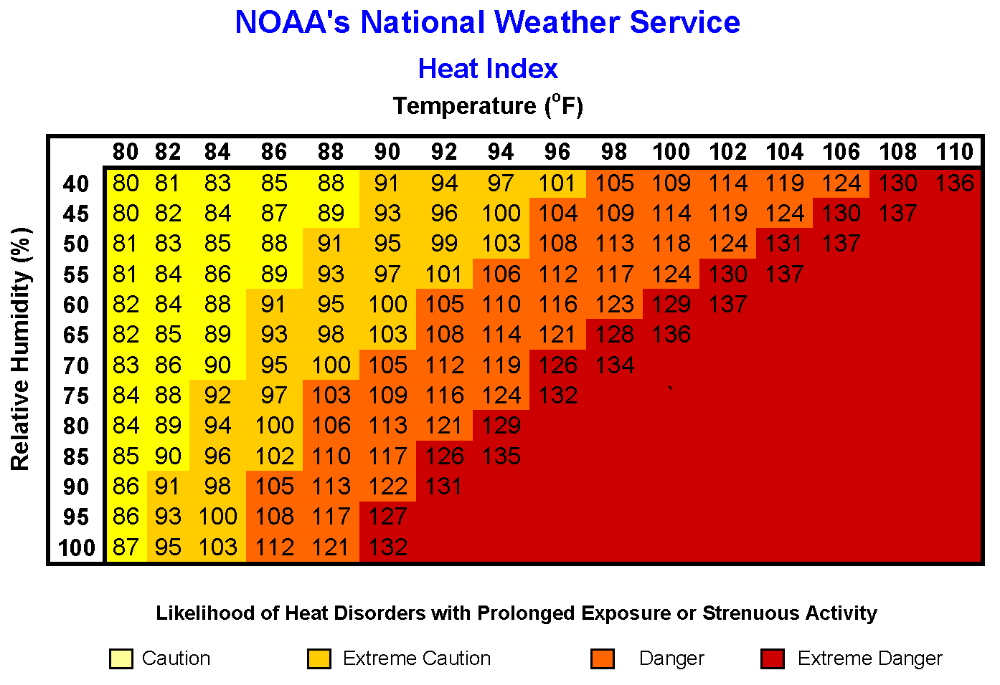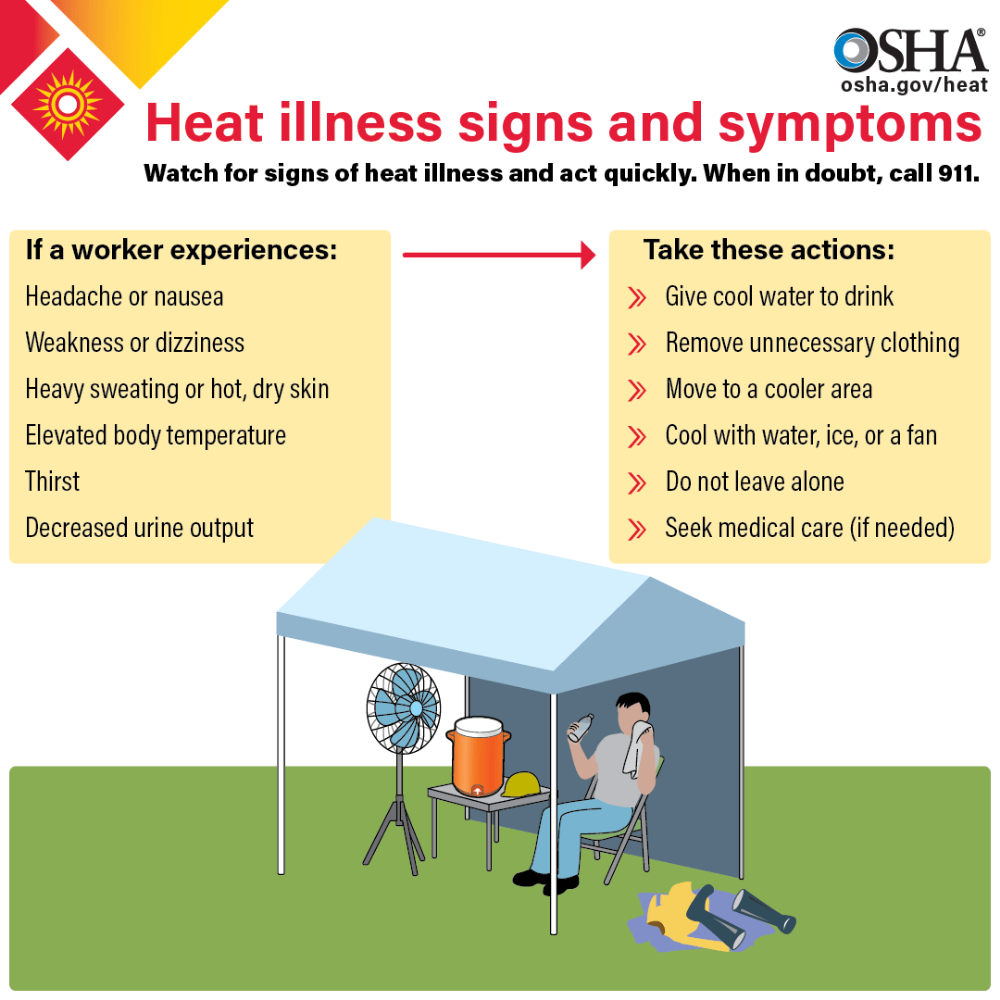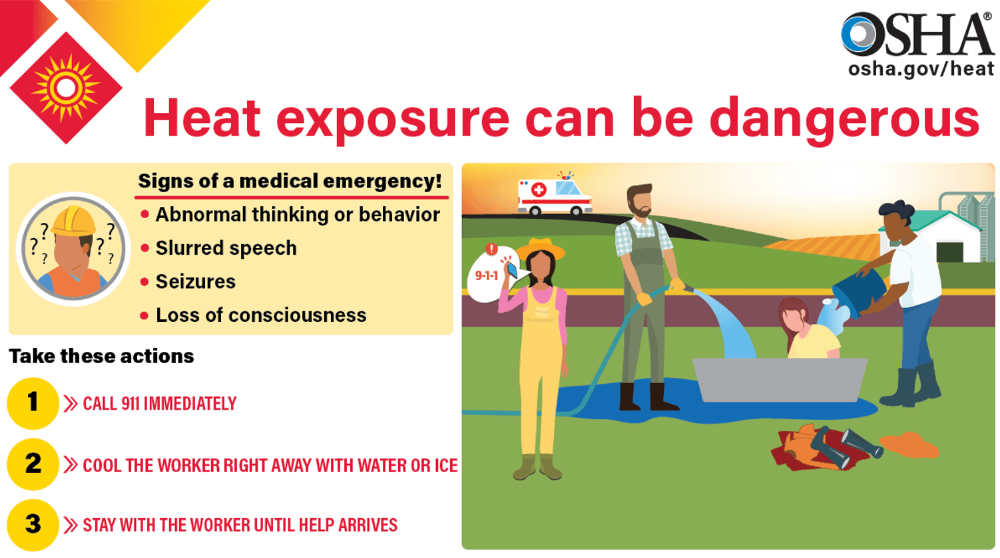 |
Written by Liz McDermott |

The scorching heat of summer can be unbearable for anyone, including indoor workers, but it poses an even greater risk for outdoor workers. Heat-related illnesses can have serious consequences, ranging from heat rash and cramps to life-threatening conditions like heat stroke. To protect workers from these potential dangers, it is essential to implement effective heat illness prevention strategies.
This comprehensive article provides everything you need to know about protecting workers from heat illness. It explores the signs and symptoms of heat illness, discusses the risk factors, and offers practical tips on creating a safe and healthy working environment.
Whether you are a business owner, a manager, or a worker, this article will equip you with the knowledge and resources to ensure the well-being of everyone on your team.

TABLE OF CONTENTS:
- The Importance of Understanding Heat-Related Illnesses
- Common Risk Factors For Heat Illness
- Heat Illness Symptoms
- Importance of Heat-Related Illness Prevention in the Workplace
- Implementing An Effective Heat Illness Prevention Program
- Monitoring and Assessing Heat Stress Levels
- Heat Illness Prevention in Specific Industries
- Legal Requirements and Regulations for Working in Hot Weather

The Importance of Understanding Heat-Related Illnesses
Heat illness occurs when the body's core temperature rises to dangerous levels due to prolonged exposure to high temperatures and humidity. There are several types of heat illnesses, ranging from mild to severe. The most common ones are heat edema, heat syncope, heat rash, heat cramps, heat exhaustion, and heat stroke.
Heat edema, or swelling, is most noticeable in the ankles and occurs among workers who are not accustomed to working in the heat.
Heat syncope, or fainting, results from heat causing blood vessels to swell. When this happens, the fluid in the body moves into the legs, which causes low blood pressure and may result in fainting. Symptoms that could lead to heat syncope include: feeling light-headed and having pale, cold, and moist skin.
Heat rash, also known as prickly heat, is a common skin condition that occurs when sweat ducts become blocked, leading to small red bumps or blisters on the skin. It is often accompanied by itching and discomfort. Heat cramps, on the other hand, are painful muscle contractions that typically affect the legs, arms, or abdomen. An electrolyte imbalance causes them due to excessive sweating.
Heat exhaustion is a more serious heat-related illness that occurs when the body cannot cool itself properly. Symptoms include heavy sweating, weakness, dizziness, nausea, headache, and rapid heartbeat. If left untreated, heat exhaustion can progress to a medical condition resulting in heat stroke, a life-threatening situation. Heat stroke is characterized by a body temperature of 40°C (104°F) or higher, confusion, seizures, loss of consciousness, and hot, dry skin.
Common Risk Factors For Heat Illness
Certain factors can increase the risk of heat illness. These include high temperature and humidity, direct sunlight, air stagnation, strenuous physical activity, and inadequate rest and recovery time. Additionally, certain medical conditions, such as obesity, heart disease, and diabetes, can make individuals more susceptible to heat stress.
Outdoor and indoor workers in hot environments or in specific industries are also at a higher risk of experiencing heat illness. Construction workers, agricultural workers, bakery workers, firefighters, miners, and those in the manufacturing sector are particularly vulnerable due to the nature of their work. These workers often have to perform physically demanding tasks outdoors, exposing them to extreme heat for extended periods of time.
Wet-Bulb Temperatures
When the humidity and air temperature are high, we sweat to cool down, but water evaporation is slower in humid conditions, which means we cool down more slowly. Since humans generate more heat through physical effort, this can lead to our internal body temperature rising above 37°C (98°F).
Sweating is responsible for approximately 80% of heat loss in the human body. Suppose the wet-bulb temperature exceeds 30°C (86°F) and persists beyond six hours. In that case, it can put the human body at risk of hyperthermia and even death because it reaches a particular heat load impacting the body's inability to cool down fast enough. This makes high wet-bulb temperatures hazardous.
💡 Resource: Wet-bulb temperature calculator

Heat Illness Symptoms
It is crucial to recognize heat illness symptoms to take prompt action and prevent further complications. The symptoms may vary depending on the severity of the condition, but common signs include:
- Excessive sweating
- Pale or flushed skin
- Muscle cramps
- Fatigue
- Dizziness
- Headache
- Nausea
- Confusion
If outdoor workers exhibit any of these symptoms, it is important to provide immediate first aid and seek medical attention. Move the workers to a shaded area, have them lie down, and elevate their legs.
Loosen or remove any tight clothing and apply cold compresses or ice packs to help lower their body temperature. Encourage them to drink plenty of fluids, preferably cold water or sports drinks that contain electrolytes.

Importance of Heat-Related Illness Prevention in the Workplace
Heat illness prevention is about complying with legal requirements and prioritizing worker safety and well-being. Heat exposure can lead to health effects that decrease work performance, increase absenteeism, and cause death.
In addition to the human cost, heat exposure can have financial implications for businesses. Medical expenses, workers' compensation claims, and potential lawsuits can all result from inadequate heat illness prevention measures. Therefore, it is in the best interest of both employers and employees to prioritize heat illness prevention.

Implementing An Effective Heat Illness Prevention Program
An effective heat illness prevention program should encompass various elements to ensure the well-being of workers. One of the key components is acclimatization, which involves gradually exposing employees to hot environments to allow their bodies to adapt. This process helps reduce the risk of heat illness by enabling the body to regulate its temperature better.
Other important aspects are providing personal protective equipment, adequate hydration and rest breaks, and safety training so workers can recognize the signs of a heat-related illness. Provide shade for outdoor work.
Providing Adequate Hydration and Rest Breaks
Proper hydration is crucial for preventing heat illness. Encourage workers to drink cold water before, during, and after work, even if they are not feeling thirsty. Avoid beverages that contain caffeine or alcohol, as these can contribute to dehydration. Provide easy access to cold drinking water and consider implementing a buddy system to encourage employees to look out for each other's hydration needs.
In addition to hydration, rest breaks are equally important. Schedule frequent breaks in shaded areas to allow workers to recover from the heat. These breaks should be long enough to provide sufficient rest, ideally around 15 minutes every hour. Use this time to educate employees about the signs and symptoms of heat illness and remind them of the importance of staying hydrated.
Educating Workers About Heat Illness Prevention
Proper safety training is vital in preventing heat illness. Workers should be educated about the risks and symptoms of heat illness and the importance of preventive measures. Training sessions should cover topics such as recognizing the signs of heat illness, understanding the importance of hydration and rest breaks, and using personal protective equipment (PPE) effectively. Some organizations also offer online courses and training modules that employers and employees can access on demand.
It is also essential to educate workers on how to acclimatize to hot environments and recognize their limitations. Encourage exposed workers to speak up if they are experiencing any symptoms of heat illness and promote a culture of open communication regarding workplace safety.
Using Appropriate Personal Protective Equipment (PPE)
Personal protective equipment (PPE) plays a crucial role in protecting workers in hot climates. It is important to provide workers with appropriate PPE suitable for the hot environment they are working in. This may include lightweight and breathable clothing, wide-brimmed hats, and sunglasses to protect against direct sunlight.
In addition to clothing, consider providing cooling vests or neckbands that use evaporative cooling technology. These PPE items can help regulate body temperature and provide relief from the heat. Ensure workers are trained to use and maintain PPE to maximize effectiveness.
Monitoring and Assessing Heat Stress Levels
Regular monitoring and assessing heat levels are essential to identify potential risks and take preventive action. Employers should invest in monitoring tools, such as wet bulb globe temperature (WBGT) meters, to measure environmental conditions accurately. WBGT meters consider temperature, humidity, and radiant heat to determine the heat stress index.
By regularly monitoring heat levels, employers can adjust work schedules, provide additional breaks, or even suspend work if conditions become unsafe.

Heat Illness Prevention in Specific Industries
Different industries have unique challenges when it comes to heat illness prevention. For example, construction workers often face direct sunlight and perform physically demanding tasks, while agricultural workers are exposed to high temperatures for extended periods of time. It is important to tailor heat illness prevention strategies to the specific needs of each industry.
By understanding the specific risks and challenges in each industry, companies can implement measures such as:
- Acclimatizing workers to hot weather
- Adjusting work schedules to avoid the hottest parts of the day
- Adding shade covers on worksites
- Providing frequent breaks in areas in the shade
- Implementing cold water hydration stations throughout the worksite

Legal Requirements and Regulations for Working in Hot Weather
In many countries, there are legal requirements and regulations in place to protect workers from heat illness. These regulations outline specific measures employers must take to ensure worker safety in hot environments. Businesses must familiarize themselves with these regulations and comply with the necessary guidelines.
The Canadian Centre for Occupational Health and Safety (CCOHS) provides a Hot Environments Health Effects and First Aid fact sheet, which recommends that employers train indoor and outdoor workers to recognize the signs and symptoms associated with heat illness. Especially using a "buddy system" so that it's easier to notice such symptoms.
The Occupational Safety and Health Administration (OSHA) has specific standards for preventing heat-related illnesses in the United States. Failure to comply with these regulations can result in fines, penalties, and potential legal action.
Many U.S. states have implemented standards for heat exposure that cover hazards not addressed by OSHA:
- California
Private and federal employers with outdoor workers must provide access to cold water, rest, and shade, plus ensure workers receive proper training to prevent heat illness. Additionally, businesses must have a written prevention plan available at all outdoor worksites. See the full text of the California standard. - Colorado
Agricultural employers must provide farmworkers access to shade and potable water and breaks every two hours when the temperature exceeds 35°C (95°F), which are paid if work hours extend beyond 60 hours a week. Employers must increase the number of breaks in conditions like air stagnation, long workdays, and heavy clothing. See the full text of the Colorado standard. - Minnesota
Under Minnesota’s Employee Right-to-Know Rules (Minnesota Rules 5206.0700, subparts 1 and 3), employers must provide training on the hazards of exposure to heat if exposures are expected to approach the limits in the heat stress standard. Air ventilation standards are also in place for indoor places of employment. - Nevada
The adoption of the federal program requires employers to provide heat illness prevention training to workers, including how to recognize symptoms and avoid heat illness. The state also implemented rules requiring mandatory breaks, shade, and cold water access. - Oregon
Employers with workers performing work activities in any environment (both indoor and outdoor) where the heat index is 27°C (80°F) or higher must provide annual heat illness prevention training. Additional high heat requirements apply if the heat index reaches 32°C (90°F). See requirements under Oregon's standard. - Washington
Washington State’s Outdoor Heat Exposure Rule requires employers to provide workers with heat illness prevention training and access to shade, cold hydration, and breaks. See the full text of the regulation.
Conclusion: Mitigate Heat Exposure in Outdoor and Indoor Work Environments
Protecting workers from heat illness should be a top priority for employers in all industries. Employers can create a safe and healthy working environment by understanding the risks and implementing effective prevention strategies. Each component prevents illnesses, from acclimatization to hydration and rest breaks.
Remember, heat stress prevention is about complying with legal requirements and prioritizing worker safety and well-being. By investing in proper prevention, employers can protect their workers, reduce the risk of heat-related illnesses, and ensure the long-term success of their businesses. So, take action today and create a safe working environment for all.
For more information, please contact us to inquire about our Health & Safety training programs.
